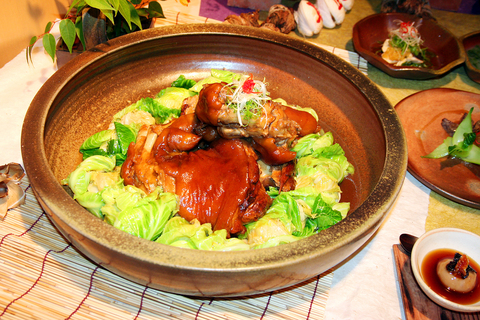"Nouveau Taiwanese cuisine" is a label that was going to stick sometime. Now that it has you can sample traditional and reinvented Hakka dishes by prize-winning chef Robin Lin (林祺豐) at the Shang Palace in the Far Eastern Plaza Hotel (台北遠東國際大飯店). The former mechanical engineering and Chinese cuisine graduate combines attention to detail and a love of food and country.
The result is a piquant and earthy style of cooking that uses local ingredients, such as clams, salty pork, Chinese cabbage, preserved turnip, intestines and fruits of the sea. Lin uses these staple foods to develop "new Taiwanese" recipes based on old formulas.
The Hakka, or "guest people," were originally from northern China, around 1,700 years ago, but settled in the south and then moved outward in a series of diasporas. Most Taiwanese Hakka settled in hilly or remote areas and typically were poor and dependant on farming. As a result their food was often preserved with salt or by pickling, in order to make the most of their seasonal harvests. It was also occasionally oily as this provided much-needed energy.

PHOTO: JULES QUARTLY, TAIPEI TIMES
This was evident in dishes such as the salty pork with preserved turnip and the spicy, salted deep-fried bomb fish. Like spice in an Indian curry or the seasoning originally used by French chefs to disguise indifferent ingredients, Taiwanese fare has evolved its own set of flavors. Preserved been curd sauce is a key element in many of the dishes and has a strong taste that would have originally given bland food some interest.
"Hakka food is generally considered to be common. Here we are making it more cultured and sophisticated so that diners can appreciate the real Hakka spirit. It is food that was originally for poor people but actually it is now considered to be good for the health and natural," Lin said.
An example of this was the clam with fried rice, wrapped with cabbage that came garnished with seaweed. The gently seasoned seaweed and clams went together perfectly and Lin explained choosing elements that complemented each other was a signature of his dishes.
Lin, who won a Hakka cuisine championship in 2005, is head chef at the renowned Hwataoyao (華陶窯) restaurant, botanical garden and ceramic studio in Miaoli County (苗栗縣). For this weeklong promotion at the Far Eastern, Lin will assist the hotel's chefs in providing nouveau Taiwanese cuisine, for the first time.

The 1990s were a turbulent time for the Chinese Nationalist Party’s (KMT) patronage factions. For a look at how they formed, check out the March 2 “Deep Dives.” In the boom years of the 1980s and 1990s the factions amassed fortunes from corruption, access to the levers of local government and prime access to property. They also moved into industries like construction and the gravel business, devastating river ecosystems while the governments they controlled looked the other way. By this period, the factions had largely carved out geographical feifdoms in the local jurisdictions the national KMT restrained them to. For example,

The remains of this Japanese-era trail designed to protect the camphor industry make for a scenic day-hike, a fascinating overnight hike or a challenging multi-day adventure Maolin District (茂林) in Kaohsiung is well known for beautiful roadside scenery, waterfalls, the annual butterfly migration and indigenous culture. A lesser known but worthwhile destination here lies along the very top of the valley: the Liugui Security Path (六龜警備道). This relic of the Japanese era once isolated the Maolin valley from the outside world but now serves to draw tourists in. The path originally ran for about 50km, but not all of this trail is still easily walkable. The nicest section for a simple day hike is the heavily trafficked southern section above Maolin and Wanshan (萬山) villages. Remains of

With over 100 works on display, this is Louise Bourgeois’ first solo show in Taiwan. Visitors are invited to traverse her world of love and hate, vengeance and acceptance, trauma and reconciliation. Dominating the entrance, the nine-foot-tall Crouching Spider (2003) greets visitors. The creature looms behind the glass facade, symbolic protector and gatekeeper to the intimate journey ahead. Bourgeois, best known for her giant spider sculptures, is one of the most influential artist of the twentieth century. Blending vulnerability and defiance through themes of sexuality, trauma and identity, her work reshaped the landscape of contemporary art with fearless honesty. “People are influenced by

Ten years ago, English National Ballet (ENB) premiered Akram Khan’s reimagining of Giselle. It quickly became recognized as a 21st-century masterpiece. Next month, local audiences get their chance to experience it when the company embark on a three-week tour of Taiwan. Former ENB artistic director Tamara Rojo, who commissioned the ballet, believes firmly that if ballet is to remain alive, works have to be revisited and made relevant to audiences of today. Even so, Khan was a bold choice of choreographer. While one of Britain’s foremost choreographers, he had never previously tackled a reimagining of a classical ballet, so Giselle was